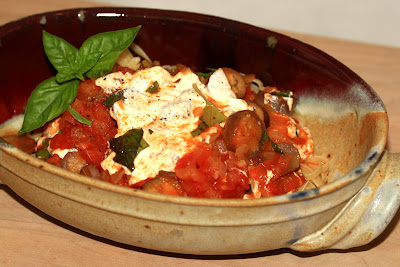 I was about to make briami, which is an oven-baked summer vegetable dish and a traditional Greek food. However, baking this dish in the oven takes more than one hour. This discouraged me a great deal. Therefore, I decided to cook this dish in a large pan.
I was about to make briami, which is an oven-baked summer vegetable dish and a traditional Greek food. However, baking this dish in the oven takes more than one hour. This discouraged me a great deal. Therefore, I decided to cook this dish in a large pan.This simmered vegetable dish is called Caponata and/or Ratatouille. Caponata is a traditional Sicilian and Neapolitan dish. Ratatouille is the typical South French dish from the Provençal region. Even though these two dishes have some differences, both of these Mediterranean dishes use many different kinds of summer vegetables.
This Caponata / Ratatouille dish has many benefits. First of all, you can eat many various vegetables all at once. Second, it is very easy to prepare and delicious. Third, it can be served either hot or cold! Finally, it is very-very healthy.
Some people add sugar, vinegar, wine or bacon/meat in Caponata and Ratatouille. However, I like simply cooked summer vegetables with salt and pepper. These vegetables produce plenty of juices. The flavors of basil and oregano enhance these delicious summer vegetables. Thus, no need for additional seasoning.
Ingredients (4 servings):
2 ripe tomatoes
2 zucchinis
2 Japanese eggplants (or Holland eggplants)
1 squash
1 onion
2 cloves of garlic
½ teaspoon of dry oregano
3 strings of basil leaves
Salt and freshly ground black pepper
Extra virgin olive oil
Optional: other summer vegetables!
Directions:
1. Cut the eggplants into small pieces. Soak them into salty water for about 10 minutes. Then, drain them well.
2. Cut the tomatoes, zucchinis, eggplants, squash, and onion into small pieces. Cut the garlic finely. Wash the basil leaves.
3. Heat the olive oil in a large pot and fry the chopped onion and garlic. Add eggplants, squash, zucchinis and tomatoes. Add the dry oregano. Simmer for 15 to 20 minutes until all of the vegetables become soft.
4. Season with salt and black pepper. Before turn off the heat, add the basil leaves and cover the pot.
5. Transfer to the serving plates. Serve either hot or cold!









 Directions:
Directions:







